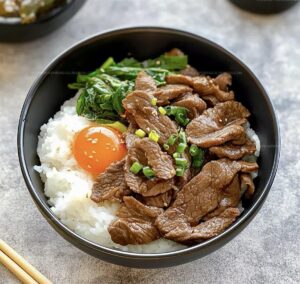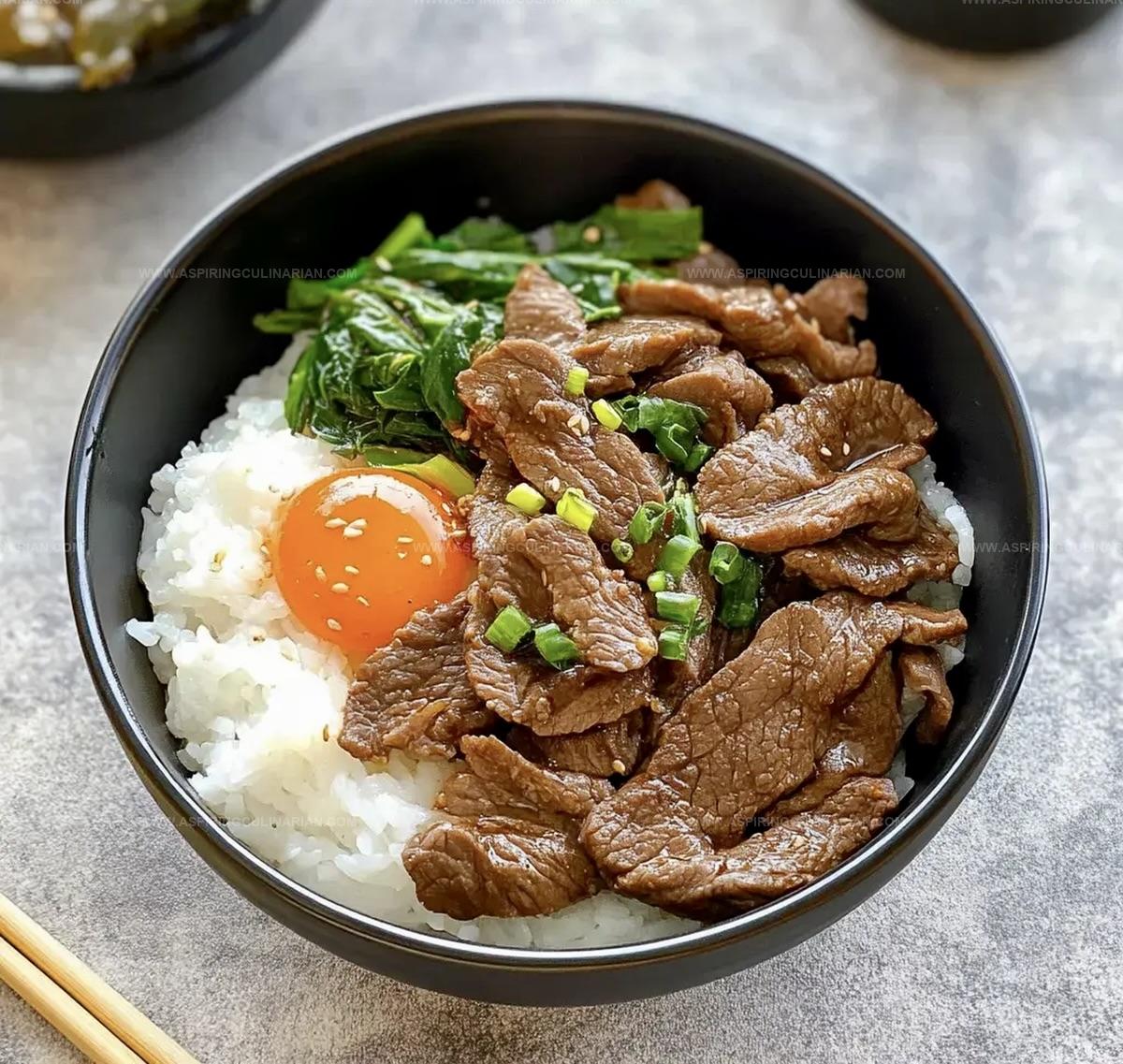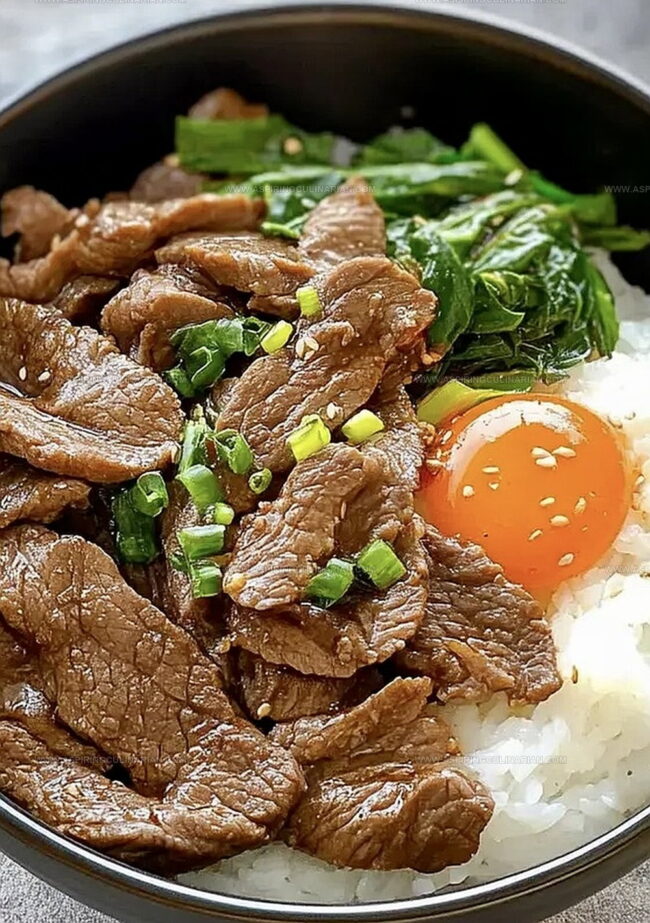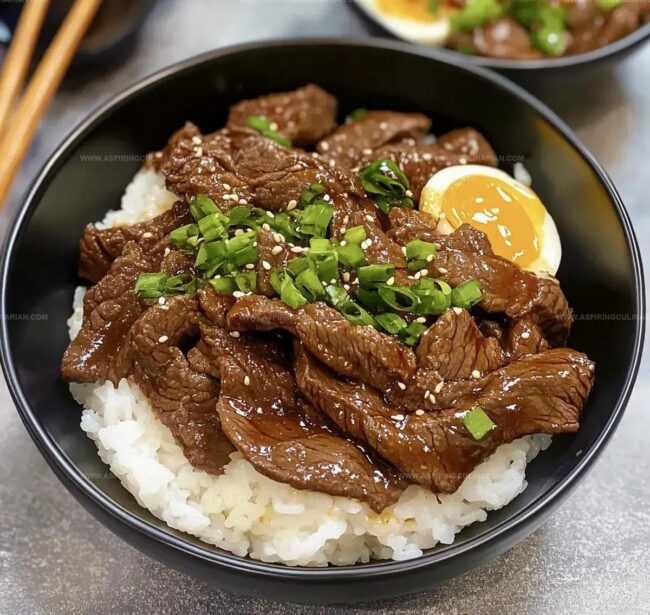Easy Japanese Beef Bowl Gyudon Recipe That Warms Your Soul
Comfort meets convenience in this hearty (gyudon) that brings Tokyo street food right to your kitchen.
Savory slices of beef melt over steaming rice, creating a symphony of flavors.
Home cooks adore this quick one-pan wonder for its simplicity and robust taste.
Tender meat simmered in a sweet-salty sauce captures the essence of Japanese home cooking.
Weeknight dinners become extraordinary with this soul-warming recipe that takes less than 30 minutes to prepare.
Fragrant onions and melt-in-your-mouth beef promise a culinary journey you won’t forget.
Grab your chopsticks and let’s make magic happen!
Japanese Beef Bowl (Gyudon) for Rice Lovers
Gyudon Ingredients for Authentic Japanese Beef Flavor
Main Ingredients:Sauce Ingredients:Cooking Ingredients:Japanese Beef Bowl Cooking and Layering Instructions
Step 1: Prepare Beef Slices
Place beef in the freezer for 1.5-2 hours to make it slightly firm.
This technique helps you slice the meat into ultra-thin, elegant strips with precision and ease.
Step 2: Create Flavor Mixture
In a small bowl, whisk together:Stir until the sugar completely dissolves, creating a rich and glossy sauce base that will infuse the beef with incredible depth.
Step 3: Soften Onions
Warm vegetable oil in a skillet over medium heat.
Add sliced onions and gently cook them until they transform into soft, translucent golden rings, releasing their sweet aromatic essence.
Step 4: Cook Beef and Ginger
Introduce the thinly sliced beef and freshly grated ginger to the onion-filled pan.
Sauté until the meat loses its pink color and develops a beautiful, appetizing brown exterior.
Step 5: Combine and Simmer
Pour the prepared flavor mixture over the beef.
Stir thoroughly and allow the sauce to simmer for 2-3 minutes, creating a glossy, rich coating that clings to each meat slice.
Step 6: Create Beautiful Bowl
Spoon steamed rice into a serving bowl.
Generously top with the beef mixture.
Tips for Tender Beef and Flavorful Rice Bowls
Gyudon Variations to Suit Every Topping Craving
Serving Japanese Beef Bowl Gyudon for Quick Meals
Gyudon Storage for Meal Prep and Reheating
FAQs
Thinly sliced ribeye or sirloin works perfectly. These cuts are tender, flavorful, and slice easily when slightly frozen.
If you don’t have sake, you can substitute with dry white wine or additional mirin. The key is maintaining a balance of sweet and savory flavors.
Aim for paper-thin slices, approximately 1/8 inch thick. Freezing the beef for 1.5-2 hours helps achieve these precise, thin cuts.
Gyudon is a classic Japanese comfort food, traditionally served in small restaurants and food stalls across Japan. It’s a popular quick meal enjoyed by many Japanese people.
Print
Japanese Beef Bowl Gyudon Recipe
- Total Time: 2 hours 10 minutes
- Yield: 2 1x
Description
Hearty Japanese beef bowl gyudon promises a delightful dance of savory flavors that transport diners straight to Tokyo’s bustling streets. Tender slices of marinated beef nestled over steaming rice create a perfect harmony of comfort and culinary tradition you’ll crave again and again.
Ingredients
Main Protein:
- 14 ounces (397 grams) thinly sliced beef (ribeye, chuck, or sirloin)
- 2 poached eggs
Vegetables and Aromatics:
- 1 medium onion (sliced)
- 1 teaspoon ginger (grated or paste)
- Spring onions (sliced, to serve)
- Japanese red pickled ginger (optional, to serve)
Sauce and Cooking Ingredients:
- 1 tablespoon vegetable oil
- 3 tablespoons soy sauce
- 2 tablespoons mirin
- 1 tablespoon sake
- 2 tablespoons brown sugar
- Steamed rice (to serve)
Instructions
- Chill beef in freezer for 1.5-2 hours to achieve precise, paper-thin slicing, creating ideal texture for quick cooking.
- Craft sauce by whisking soy sauce, mirin, sake, and brown sugar until sugar completely dissolves, ensuring smooth consistency.
- Warm vegetable oil in skillet at medium heat, then gently sauté onions until they become soft, translucent, and develop a delicate sweetness.
- Introduce thinly sliced beef and minced ginger to the pan, stirring rapidly to prevent overcooking and maintain tender meat quality.
- Stream prepared sauce over beef mixture, coating ingredients thoroughly and allowing liquid to reduce and caramelize for 2-3 minutes.
- Plate steamed rice as foundation, generously ladle beef mixture over grains, crown with optional soft poached egg, garnish with fresh spring onions and tangy pickled ginger for authentic Japanese flavor profile.
Notes
- Slice beef when partially frozen to achieve paper-thin cuts without struggling with the knife, ensuring tender meat that cooks quickly and absorbs sauce perfectly.
- Use high-quality thinly sliced beef like ribeye or sirloin for authentic Japanese texture and rich flavor that melts in your mouth.
- Adjust sauce sweetness by varying brown sugar amounts – less for a more savory profile, more for a slightly caramelized finish that complements the beef.
- Create gluten-free version by substituting traditional soy sauce with tamari and ensuring all other ingredients are certified gluten-free for sensitive diets.
- Prep Time: 2 hours
- Cook Time: 10 minutes
- Category: Dinner, Lunch
- Method: Sautéing
- Cuisine: Japanese
Nutrition
- Serving Size: 2
- Calories: 680 kcal
- Sugar: 14 g
- Sodium: 1100 mg
- Fat: 35 g
- Saturated Fat: 12 g
- Unsaturated Fat: 20 g
- Trans Fat: 0.5 g
- Carbohydrates: 45 g
- Fiber: 3 g
- Protein: 38 g
- Cholesterol: 280 mg





Nathaniel Brooks
Founder & Recipe Developer
Expertise
Farm-to-table cuisine, Seasonal recipe development, Culinary storytelling
Education
Ivy Tech Community College – Indianapolis, IN
Culinary Arts / Hospitality Administration & Events
Focused on hands-on training in classical and modern culinary techniques.
Nathaniel’s story starts in the foothills of the Appalachian Mountains, where farm stands, backyard gardens, and old family recipes shaped his love for real food. After graduating from Ivy Tech Community College in Indianapolis, he spent years working in farm-to-table kitchens, learning how to turn local, seasonal ingredients into something memorable.
Today, Nathaniel pours that same spirit into every single recipe on Aspiring Culinarian – recipes that feel real, comforting, and connected to the land. When he’s not in the kitchen, you’ll find him foraging wild herbs, chasing sunsets with his camera, or writing about the flavors that shaped his roots.